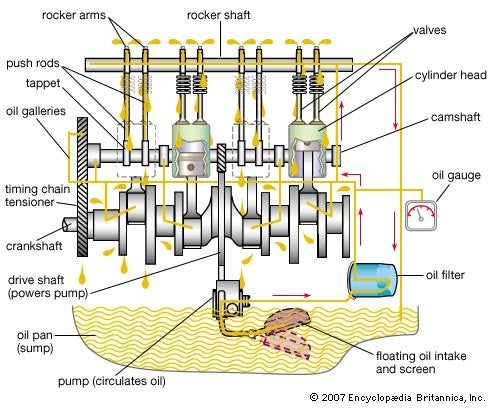The basics of lubricants: how does engine oil work? (5/9)

Ever wondered how a lubricant helps an engine perform? Here's a quick tour, plus an overview of a lubricant's most important functions.
In the series on the basics of lubricants, we've shown you which ones are important to know, what their main function is, what they are composed of and what functions the different "ingredients" serve (like base oils and additives ).
This time, we're going to get a little bit more practical: we'll show you how a lubricant effectively travels through an engine. Then, we'll walk you through the most important functions of a lubricant.
How oil flows through an engine

An engine is a highly complicated piece of machinery. But to paint the larger picture, here's how it works in terms of lubrication:
- The oil pump picks up oil from the oil pan (both in the lower part of the picture), where the oil is stored.
- The pump sends the oil up to the main bearings of the crankshaft (in the lower middle), which converts linear energy into rotational energy.
- From there, the oil moves through oil holes drilled in the crankshaft, to the rod bearings, and then through an oil line to the cylinder head (in the upper middle).
- Through the oil galleries, it flows to the camshaft bearings and valves.
- The pistons, rings and pins (not indicated in the picture) receive oil thrown off the connecting rod-bearings.
Why is it important to lubricate an engine?
The three major functions that lubricants perform are:
- Reducing friction
- cooling
- and cleaning
Reducing friction is what most people would think of when asked what a lubricant does. With all its parts that move quickly and very close to each other, an engine would not survive for long without a lubricant to 'smoothen things up'.
Cooling is necessary because a working engine heats up to high temperatures. Without a lubricant, it would break down from the heat it produces itself!
Cleaning concerns the impurities that exist in an engine. Combustion, the process that takes place inside an engine, produces soot and contaminants. Without lubricants these would form large deposits in the oil block passage, hindering the engine's performance as a result.
Additives make lubricants multi-functional. But lubricants have more functions.
Specialized additives help an engine maintain its performance, too. Let's take a look at three functions additives perform:
1. Control acids and corrosion
An engine collects acids. These can cause major damage in the form of corrosion, and a decrease in performance or even general engine failure. Lubricants contain detergents which neutralize the acid. This way, it prevents rust, especially on the bearings. Some high-performance lubricants additionally contain corrosion inhibitors to protect the soft metals.
2. Manage viscosity
The viscosity is the "thickness" of a lubricant. It is key to ensure that it is consistent — if a lubricant's viscosity changes, the pumps won't function well. A consistent viscosity is maintained through the use of so-called viscosity index improvers. Even when the temperature changes and an oil would normally become thicker or thinner, this additive keeps the viscosity constant.
3. Minimize oxidation
The inside of a working engine becomes burning hot, and this causes oxidation to happen faster. (Oxidation is when a material reacts with oxygen and gets damaged - rusting iron is the best-known example). As you can imagine, the oxidation of engine parts is not a good thing. It can cause sludge to build up and the viscosity to increase. Luckily, we have additives called antioxidants that do the job.
In short:
- Engine oil flows through an engine, lubricating every part.
- The three major functions that lubricants perform are: reducing friction, cooling, and cleaning.
- Specialised additives help an engine maintain its performance, too.
- Additives, among other functions, control acids and corrosion, manage viscosity, and minimize oxidation.
Missed our last article of this series? Here’s a shortcut !